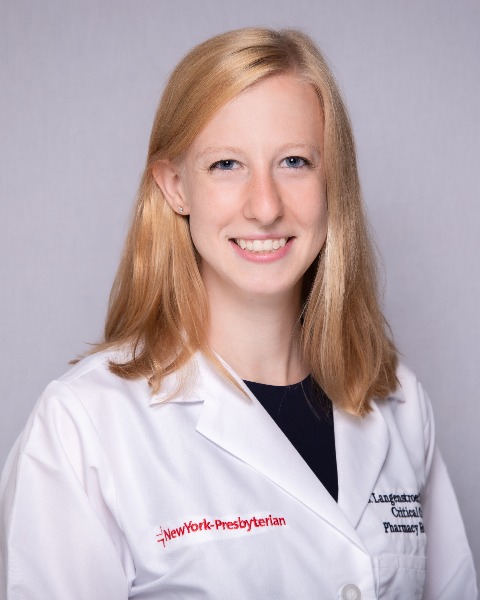Blood Volume, TBW, and BMI-Based Enoxaparin Dosing Strategies in Trauma Patients for VTE Prophylaxis
-

Elizabeth Langenstroer, PharmD,
PGY2 Critical Care Pharmacy Resident
NewYork Presbyterian Hospital
New York, NYDisclosure information not submitted.
-
DH
David Herrmann, PharmD, BCCCP
Pharmacist
Froedtert & the Medical College of Wisconsin, United StatesDisclosure information not submitted.
-
TC
Thomas Carver, MD, FACS
Director, Surgical Intensive Care
Medical College of Wisconsin Froedtert Hospital, United StatesDisclosure information not submitted.
-
GG
Gabrielle Gibson, PharmD, BCCCP, BCPS
Clinical Pharmacy Specialist
Barnes Jewish Hosptial, United StatesDisclosure information not submitted.
-
MH
Michael Ha, PharmD, BCPS, BCCCP
Critical Care Pharmacist
UMass Memorial Medical Center, United StatesDisclosure information not submitted.
-
KA
Kaitlin Alexander, PharmD
Clinical Pharmacy Specialist, Trauma ICU
University of Florida College of Pharmacy, United StatesDisclosure information not submitted.
-
KM
Kaylee Maynard, PharmD, BCCCP
Clinical Pharmacy Specialist
University of Rochester Medical Center, United StatesDisclosure information not submitted.
-
KB
Kristen Bamberg, PharmD, BCCCP, BCPS, MS
Lead Critical Care Pharmacist
Flagstaff Medical Center, United StatesDisclosure information not submitted.
-

Tyler Chanas, BCCCP, PharmD
Critical Care Clinical Pharmacist
Vidant Medical Center
Greenville, North CarolinaDisclosure information not submitted.
-
KD
Kailey Denny, PharmD
PGY2 Emergency Medicine Pharmacy Resident
Medical University of South Carolina, United StatesDisclosure information not submitted.
-
MO
Mary O'Keefe, PharmD
Emergency Medicine Clinical Pharmacist
Salem Health, United StatesDisclosure information not submitted.
-
MO
Marisa O'Brien, PharmD, BCPS
Clinical Pharmacist
UMass Memorial Medical Center, United StatesDisclosure information not submitted.
-
MC
Mariela Cardona Gonzalez, PharmD
Clinical Pharmacist
Johns Hopkins Bayview Medical Center, United StatesDisclosure information not submitted.
-
LR
Lisa Rein, ScM
Biostatistician
Medical College of Wisconsin, United StatesDisclosure information not submitted.
-
SC
Sai Ho Chui, PharmD, BCCCP, BCPS
Clinical Pharmacy Specialist, Multi-trauma Unit
University of Maryland School of Pharmacy, United StatesDisclosure information not submitted.
-
BH
Brandon Hobbs, PharmD, BCPS
Clinical Pharmacist, Surgical Critical Care
Orlando Regional Medical Center, United StatesDisclosure information not submitted.
-
MP
Mehrnaz Pajoumand, PharmD, BCCCP, BCPS
Clinical Pharmacy Specialist, Lung Rescue Unit and Neuro-trauma Unit
University of Maryland Medical Center, United StatesDisclosure information not submitted.
-

William Peppard, PharmD, BCPS
Pharmacist
Froedtert & The Medical College of Wisconsin
Milwaukee, WisconsinDisclosure information not submitted.
First Author(s)
Co-Author(s)
Title: Blood volume, TBW, and BMI-based enoxaparin dosing strategies in trauma patients for VTE prophylaxis
Introduction: Fixed-dose enoxaparin (ENOX) regimens provide inadequate venous thromboembolism (VTE) prophylaxis for many trauma patients. Dosing based on total body weight (TBW) or body mass index (BMI) are more effective at achieving target anti-Xa activity. A recent single center study showed that a blood volume (BV)-based ENOX dosing guideline increased attainment of target anti-Xa levels significantly compared to BMI. This multicenter study was designed to evaluate the effectiveness of BV, TBW, and BMI prophylactic ENOX dosing strategies at achieving target anti-Xa levels in trauma patients.
Methods: A multicenter retrospective chart review of adult trauma patients who received ENOX for VTE prophylaxis from Sep 2016 to Dec 2020 was performed. Patients were included if they received > 3 consecutive doses of ENOX and had an appropriately timed anti-Xa level. The primary outcome was achieving target anti-X level (0.2-0.5 IU/mL); regression analysis and pairwise comparisons were performed. VTE and bleeding rates were also noted.
Results: A total of 478 adult trauma patients from six institutions were included. Most patients (65%) were male with a mean age of 45 years. Mean BV was 5.6 L, TBW 99 kg, and BMI 33 kg/m2. Patients were dosed on BV (30%), TBW (8%), and BMI (62%); the BMI approach yielded the most patients receiving 30 mg ENOX (49%) while BV yielded the most receiving 40 mg ENOX (58%). Target anti-Xa level attainment was 80% (BV), 62% (TBW), and 57% (BMI) (p< 0.01). Multiple adjusted logistic regression identified BV vs BMI and female sex to be associated with being on or above target anti-Xa level. Post-hoc pairwise comparisons favored BV for target attainment, BV:BMI odds ratio 3.22 [95% CI 1.98, 5.24], but did not differ for BV:TBW or TBW:BMI. VTE rates did not differ between groups (3.5%, 2.6%, and 2.7%, respectively, p=0.91), nor did bleed rates (2.1%, 0%, and 3.4%, respectively, p=0.61).
Conclusion: A BV-based ENOX dosing guideline for VTE prophylaxis in trauma patients is comparable with TBW- and superior to BMI-based guidelines for achieving target anti-Xa levels. A prospective validation study is warranted.
